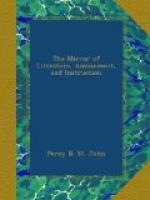Sir Richard Phillips, in his recent “Personal Tour,” says, “on inquiring for relics of honest Bunyan, I was introduced to Mr. Hilyard, the present amiable and exemplary pastor of the large Independent Congregation, which 150 years since was under the spiritual care of Bunyan. Mr. H. at his meeting-house, showed me the vestry-chair of Bunyan; and the present pulpit is that in which Bunyan used to preach. At his own house he preserves the records of the establishment, many pages of which are in a neat and very scholastic hand by Bunyan, and contain many of his signatures.”
Bunyan’s imprisonment gave rise to “The Pilgrim’s Progress,” a work, which like “Robinson Crusoe,” has remained unrivalled amidst a host of imitators. He was too, a wit as well as a preacher. Towards the close of his imprisonment a Quaker called on him, probably to make a convert of the author of the Pilgrim. He thus addressed him:—“Friend John, I am come to thee with a message from the Lord; and after having searched for thee in half the prisons in England, I am glad that I have found thee at last.” “If the Lord had sent you,” sarcastically replied Bunyan, “you need not have taken so much pains, for the Lord knows that I have been a prisoner in Bedford Gaol for these twelve years past.”
* * * * *
SKELETON OF AN ELEPHANT.
The bones of poor Chunee, the stupendous elephant shot at Exeter ’Change, in 1826, have, at a considerable expense, been accurately articulated, and the entire skeleton is now exhibiting in one of the chambers at “the Egyptian Hall,” in Piccadilly. We remember the interest, the “sensation,” which the death of Chunee occasioned: it was a fertile incident—for we gave an engraving of the enormous deceased in his den at Exeter ’Change. It is little more than three years since, and probably in three years more, Chunee will figure in books of Natural History, and Exeter ’Change in the antiquarian’s portfolio.
We recommend the Naturalist and all such as delight in contemplating sublime objects of nature, to see this skeleton; and there can scarcely be an exhibition better calculated to impress the youthful mind with the vastness of creation. It stands nearly 13 feet high, and the clear space beneath the ribs is 6 feet.
It would, we think, suit the Zoological Society, and make a fine nucleus for their Museum.
* * * * *




